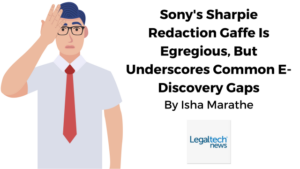Litigation paralegals and tight redaction checks are vital to preventing inadvertent disclosures during production. But too often, such controls are not put in place.
[Editor’s Note: This analysis by Legal Tech reporter, Isha Marathe, was first published June 14, 2023 in Legaltech News. Read the entire analysis here.]

As a part of the Federal Trade Commission v. Microsoft lawsuit, technology company Sony had to produce several documents, one of which was a report—with confidential financial details redacted—sent by PlayStation chief Jim Ryan. Unfortunately, on June 28, things didn’t go according to plan.
The redactions were made in black Sharpie instead of using redaction tape, or redaction software, a more common method. The problem: When one scans a document, the Sharpie ink can occasionally lighten, making some redactions visible on the electronic document.
For Sony, this meant the inadvertent disclosure of the profit margins the company shares with its publishers, along with revenue details relating to its “Call of Duty” franchise, among other proprietary financial information. While the court worked to remove the document from the public domain, it was already too late. Sony’s competition downloaded the report, while media outlets quickly analyzed its findings.
…to my eye, the borders of the redactions are too uniform and the leading and trailing edges too consistently rounded to suggest a human hand holding a permanent marker. My guess is that the HTML color code for the shade of black used to overwrite was not exactly the same as the HTML color of the text and, when the image was rendered, the difference manifested in the artifacts seen on the document.
Craig D. Ball
For e-discovery professionals, the entire situation comes as less of a shock and more of a clarion call for better redaction practices. Indeed, in spite of it being one of the oldest cogs in the production chain, redaction still seems to flummox many—from the defense, the prosecution, and government entities alike.
Read the entire analysis here.


